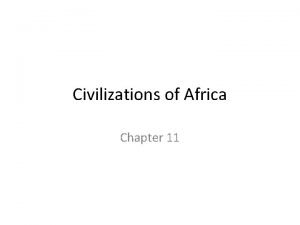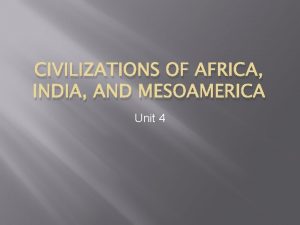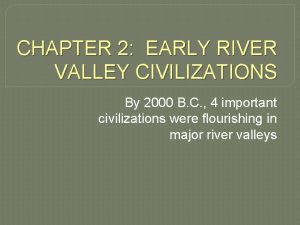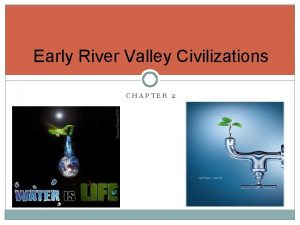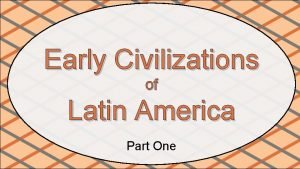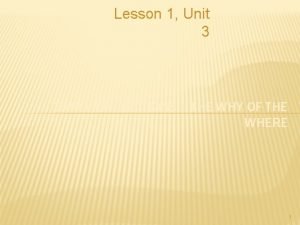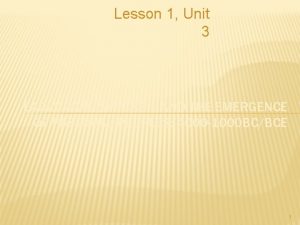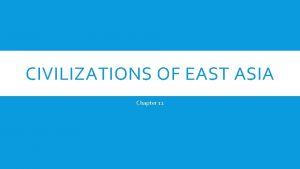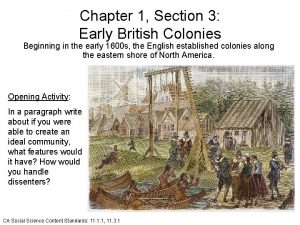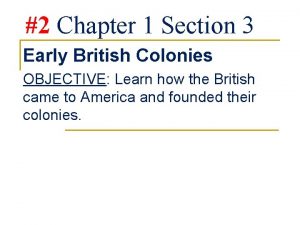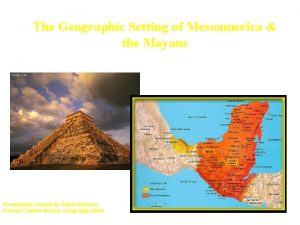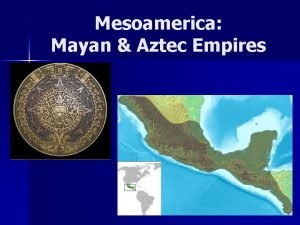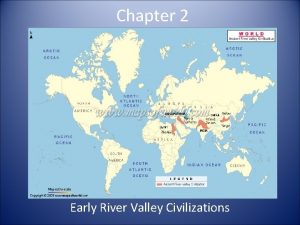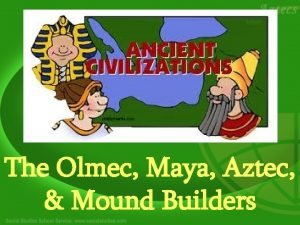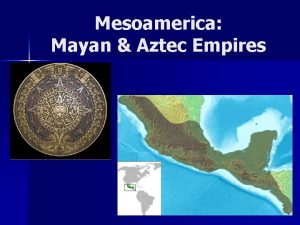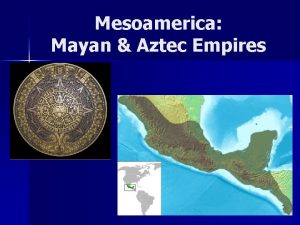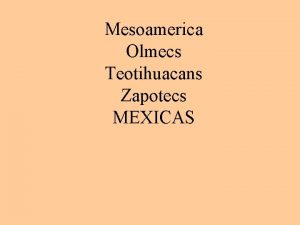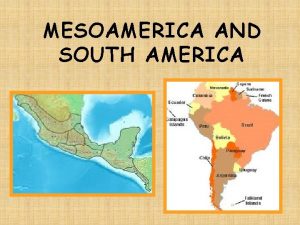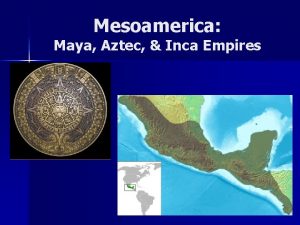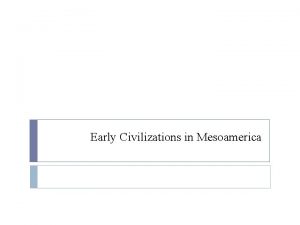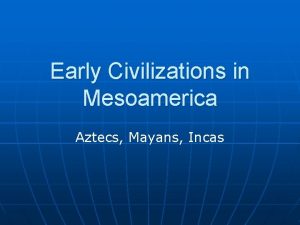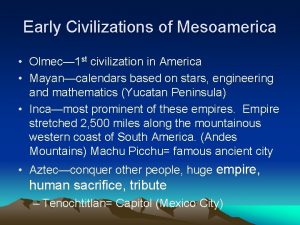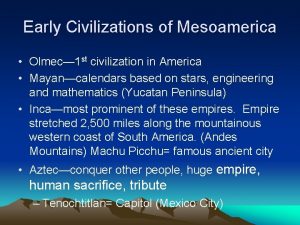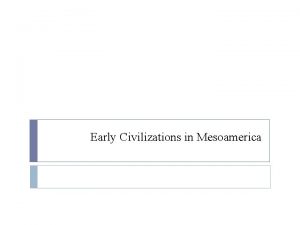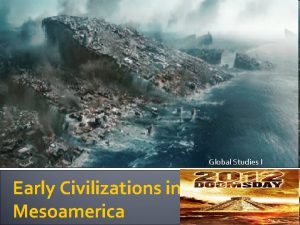Early Civilizations in Mesoamerica Chapter 11 Section 2
















- Slides: 16

Early Civilizations in Mesoamerica Chapter 11 Section 2

The Olmec and Teotihuacan • Mesoamerica – Mexico and Central America prior to Spanish colonies • Olmec – 1 st civilization in the region (1200 to 400 BCE) – Settled on the coast of Central America on the Gulf of Mexico – Farmed in the river banks – Large cities for religious purposes • Teotihuacan (250 BCE to 800 CE) – First major city “Place of the Gods” – Historians are unsure of who the founders were – Residents were mostly farmers, but the city was a trading center

The Maya and Toltec • Yucatan Peninsula – central American peninsula that is surrounded by the Gulf of Mexico • Maya - civilization on the Yucatan from 300 to 900 CE – Built temples, pyramids, and developed a complex calendar – Begins to decline (invasion, revolts, overuse of land, etc) – Not rediscovered until the late 19 th early 20 th century

Political Structures • Maya was composed of city-states – Governed by a hereditary ruling class believed to be descendents of the gods – Assisted by nobles and scribes (priests) – Often at war with each other – Cities were built around a central pyramid and included other temples, palaces, and a sacred ball court – Tikal – prominent city of the Mayan civilization

Social Structures • Society included artisans, officials, merchants, and farmers • Main belief that all of life was in the hand of divine powers • Polytheistic • Practiced human sacrifice to satisfy the gods and for special ceremonies

Writing • Writing was done through hieroglyphs pictures representing words – Unfortunately the Spanish did not decipher them, instead since they felt they were evil and of no value they burned the books that were found – Although some survived (4), scholars still have not deciphered most of the language

Calendar • Calendar is known as the Long Count – cycles of creation and destruction – Solar calendar – 365 days, 18 months of 20 day with five left at the end of the year – Sacred calendar – 260 days – 13 weeks of 20 days each – used and read by only trained priests – Used to record important events in Mayan history

Toltec • Warlike people who conquered other civilizations around them including the Maya • Existed from 900 to 1200 CE • Center of the civilization was in Tula (present day Mexico City) • Built pyramids and palaces • Chichen Itza – second capital located in the northern part of Yucatan Peninsula

Rise of the Aztec • Emerge as a civilization in the 1100 s and decline as a result of Spanish invasion in 1520 • Tenochtitlan – capital city of the Aztecs, built on an island in Lake Texcoco (Mexico City) • Legend of the journey - the sun God Huitzilopochtli, would give them a sign to end their journey • In 1325 they were attack by another people and driven to Lake Texcoco where they saw an eagle perched on a cactus on a rock (the sign)

Rise of the Aztec • They built the city over the course of the next 100 years – built temples, houses, and other buildings (markets, palaces etc. ) • The main temple (pyramid) was built to honor Huitzilopochtli • Connected to the various islands and the mainland with stone roads • Warrior culture that allied with the neighboring people to form a large empire that was semi-independent • Aztec ruler required conquered people to pay tribute – (goods or money paid to conquers from conquered people)

Political Structure • Monarchy – ruler claimed he was a descendent of the gods • Did not run the empire alone (lords and government officials) • General population – commoners (farmers and merchants), indentured workers (landless laborers), and slaves (people captured in war) • Boys trained to be warriors, girls stayed in the home • Women could own and inherit property, enter into contracts, and become priestesses

Religion and Culture • Polytheistic • Huitzilopochtli – sun god • Quetzalcoatl – feathered serpent – according to legend he would return (Toltec prince that was exiled) • When the Spanish arrived they thought they were representatives of Quetzalcoatl

Religion and Culture • Religion based on unending struggle between good and evil in the universe • Time of the 5 th sun • Protection from destruction offered in the form of human sacrifice to Huitzilopochtli • Architecture – Known for their expansive pyramids – Main

Destruction of the Civilization • Government was central rule • Authority was with the king in Tenochtitlan • Local lords in Tlaxcala wanted to gain more independence • Since they were a warrior culture they had many enemies, but few wanted to go to war instead they just wanted to remain free of Aztec rule

Destruction of the Civilization • 1519 – Hernan Cortes arrived in Veracruz and took a small group of men and horses inland to Tenochtitlan • Along the way they allied with enemies and oppressed people under the Aztec empire including Tlaxcala • Meets with Montezuma who thinks they are reps of Quetzalcoatl • Eventually problems arise between the Spanish and Aztecs and the Spanish are driven out of the city

Destruction of the Civilization • After four months the Aztecs surrender for numerous reasons – what are they? • Diseases weakened their immunity • New soldiers arrive • The people of Tlaxcala provide 50, 000 men to assist the Spanish in the attack on Tenochtitlan • Advanced weaponry • Cortes and his men level the pyramids and build churches and government buildings with the stones for the Spanish
 Chapter 11 section 1 early civilizations of africa
Chapter 11 section 1 early civilizations of africa Civilizations of mesoamerica
Civilizations of mesoamerica Chapter 9 lesson 1 ancient india
Chapter 9 lesson 1 ancient india Lesson quiz 14-2 pre-columbian america answers
Lesson quiz 14-2 pre-columbian america answers River valley civilizations def
River valley civilizations def Chapter 2 early river valley civilizations
Chapter 2 early river valley civilizations Inca diorama
Inca diorama Lesson 1 early civilizations
Lesson 1 early civilizations Unit 3 lesson 1 sumer and mesopotamia
Unit 3 lesson 1 sumer and mesopotamia Lesson quiz 11-1 civilizations of east asia
Lesson quiz 11-1 civilizations of east asia Chapter 26 civilizations in crisis the ottoman empire
Chapter 26 civilizations in crisis the ottoman empire Chapter 1 section 1
Chapter 1 section 1 Chapter 1 section 3 early british colonies
Chapter 1 section 3 early british colonies Early british colonies section 3
Early british colonies section 3 Early cpr and early defibrillation can: *
Early cpr and early defibrillation can: * Geography of mesoamerica
Geography of mesoamerica Aztec social structure
Aztec social structure
